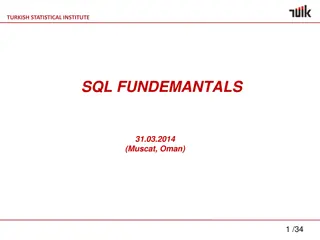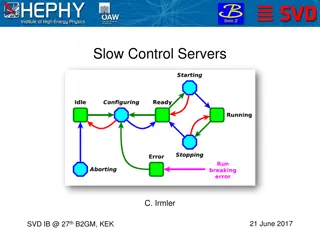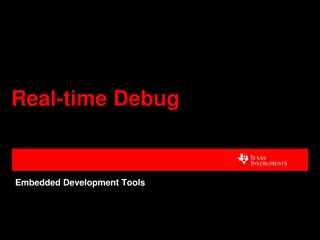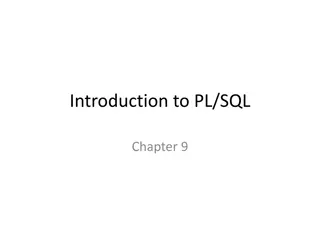Understanding SQL Server Memory Architecture and Debugging Memory Issues
Delve into the intricacies of SQL Server memory architecture with technical lead Karthick P.K. Explore topics such as Virtual Address Space, Buffer Pool, Memory-To-Leave calculation, Address Windowing Extension, and more. Discover how SQL Server responds to memory pressure and learn techniques to debug memory errors effectively.
Download Presentation

Please find below an Image/Link to download the presentation.
The content on the website is provided AS IS for your information and personal use only. It may not be sold, licensed, or shared on other websites without obtaining consent from the author. Download presentation by click this link. If you encounter any issues during the download, it is possible that the publisher has removed the file from their server.
E N D
Presentation Transcript
SQL Server memory architecture and debugging memory Issues Karthick P.K |Technical Lead | Microsoft SQL Server Support | E-mail: karthick.krishnamurthy@microsoft.com My face book group :My Facebook |My site: Mssqlwiki.com| Twitter:@mssqlwiki www.facebook.com/SQLServerGeeks
What will you get out of this session? What is VAS. What is B-pool. What is MTL. What is PAE/USERVA. What is AWE. What is Lock pages in memory. Memory DMV s. How SQL Server responds to memory pressure. How to debug SQL Server memory errors and lot of internals.
Virtual Address Space 32-Bit 64-Bit PAE in windows and AWE in SQL Server 16 EB Address Windowing Extension 64 GB Unused 4 GB KERNEL MODE 1GB -2GB KERNEL MODE 2 GB WOW KERNEL MODE 8 TB 2 TB Physical Memory Limit userVA /3GB USER MODE USER MODE USER MODE 2 GB 2GB 3GB 4GB USER MODE 8 TB BCDEdit. exe Twitter: @SQLServerGeeks www.FaceBook.com/SQLServerGeeks
VAS and Memory States Committed Working- Set SQLServr.exe C NOTEPAD.exe Committed Mapped CM KERNEL KERNEL Committed Paged-Out C C C FREE FREE RESERVED C FREE USER MODE ADDRESS SPACE CM F USER MODE ADDRESS SPACE CM FREE F CM CM NOTEPAD. EXE SQLSERVR. EXE MSVCRT. DLL Twitter: @SQLServerGeeks www.FaceBook.com/SQLServerGeeks
What is BPOOL,MTL and how are they calculated User Mode VAS MTL (Memory to Leave)= (Stack size * max worker threads) + Additional space (By default 256 MB and can be controlled by -g). Stack size =512 KB per thread for 32 Bit SQL Server I.e. = (256 *512 KB) + 256MB =384MB -g Memory To Leave BPool = Minimum (Physical memory, User address space MTL) BUF structures Buffer Pool Reference: http:\\mssqlwiki.com/sqlwiki/sql-performance/basics-of-sql-server-memory-architecture/ Twitter: @SQLServerGeeks www.FaceBook.com/SQLServerGeeks
What is AWE User Mode VAS AWE Limited to data and index pages. Every page has to be mapped and un- mapped with in my bpool for access -g Memory To Leave 64 GB Buffer Pool Reference: http://mssqlwiki.com/2010/11/11/awe-allocator-apis-how-sql-server-awe-works/ Twitter: @SQLServerGeeks www.FaceBook.com/SQLServerGeeks
SQL Server [2005, 2008, 2008 R2] Memory Manager User Mode VAS Virtual Allocator CLR -g Memory To Leave Multi-Page Allocator Memory Manager Memory Objects Single-Page Allocator Page Reservation Buffer Pool Reference: http:\\mssqlwiki.com/sqlwiki/sql-performance/basics-of-sql-server-memory-architecture/ Twitter: @SQLServerGeeks www.FaceBook.com/SQLServerGeeks
Memory Errors MemToLeave errors: SQL Server 2000 WARNING: Failed to reserve contiguous memory of Size= 65536. WARNING: Clearing procedure cache to free contiguous memory. Error: 17802 "Could not create server event thread." SQL Server could not spawn process_loginread thread. SQL Server 2005/2008 Failed Virtual Allocate Bytes: FAIL_VIRTUAL_RESERVE 122880 Buffer Pool errors: BPool::Map: no remappable address found. BufferPool out of memory condition LazyWriter: warning, no free buffers found. Either BPool (or) MemToLeave errors: Error: 17803 Insufficient memory available.. Buffer Distribution: Stolen=7901 Free=0 Procedures=1 Inram=201842 Dirty=0 Kept=572 Error: 701, Severity: 17, State: 123. There is insufficient system memory to run this query. There is insufficient system memory in resource pool default to run this query Reference http://mssqlwiki.com/sqlwiki/sql-performance/troubleshooting-sql-server-memory/ Twitter: @SQLServerGeeks www.FaceBook.com/SQLServerGeeks
Demo Twitter: @SQLServerGeeks www.FaceBook.com/SQLServerGeeks
64-Bit memory models Conventional LOCKED PAGES LARGE PAGES Twitter: @SQLServerGeeks www.FaceBook.com/SQLServerGeeks
There are three types of memory models in 64-Bit SQL Server. 1. Conventional : Normal physical page size (4 / 8KB),memory can be paged, dynamic. 2. Locked : Normal physical page size (4 / 8KB), Bpool can not be paged, dynamic, Requires startup account of SQL Server to have "Lock pages in memory" privilege, Memory is allocated by using Address Windowing Extensions (AWE) API s 3. Large : Large physical page size ( > = 2MB), Non-page able, static, Memory is committed at startup, Max server memory is recommended, requires startup account of SQL Server to have "Lock pages in memory" privilege. Reference: http:\\mssqlwiki.com/sqlwiki/sql-performance/basics-of-sql-server-memory-architecture/ Twitter: @SQLServerGeeks www.FaceBook.com/SQLServerGeeks
Memory calculations in 64-Bit SQL Server are straight forward. User VAS is large so no MTL. That doesn't mean we don t allocate out side BPOOL. SQL Server calculates the size of RAM during, max server memory the startup and reserve it , minimum of (reserved space, Max server memory ) is used as B-pool. BPOOL is capped by max server memory. When BPOOL is not capped SQL Server will grow its memory as much as possible and will not scale down its usage unless there is Low physical memory notification from windows or max server memory is reduced. When LPIM is enabled with trace flag 845 AWE allocator API s are used for memory allocation. When AWE allocator API s are used for memory allocation by SQL Server Windows can not trim the BPOOL of SQL Server. LPIM doesn t protect Non Bpool from paging. Should I have LPIM? http://sqlserverscribbles.com/2013/01/04/lock-pages-in-memory-is-recommended-or-not/ Twitter: @SQLServerGeeks www.FaceBook.com/SQLServerGeeks
Working Set Trim What is working set: Memory allocated by the process which is currently in RAM. Committed: Total memory that is allocated by process (allocated bytes can be in RAM or Page file) Working Set trimming (Paging): Windows is moving the allocated bytes of the process from physical RAM to page file because of memory pressure. Memory pressure is most commonly caused by applications or windows components that are requesting more memory causing OS to start trimming working set of other processes to satisfy these new requests. When >50% SQL Servers committed memory is pages below message is logged in errorlog A significant part of SQL Server process memory has been paged out. This may result in performance degradation. This may result in a performance degradation. Duration: 0 seconds. Working set (KB): 2007640, committed (KB): 4594040, memory utilization: 43%. message in SQL Server error log . Pay attention to Working set , committed and memory utilization(Percentage of SQL Server memory in RAM). Twitter: @SQLServerGeeks www.FaceBook.com/SQLServerGeeks
How to monitor and troubleshoot working set trim? Historical data of working set trim can be captured by using ring buffer records. Performance monitor : (Process: Private bytes and Working set ) Do not use task manager or below perfmon counters when you use LPIM, they will cheat you Performance object: Process Counter: Private Bytes Instance: sqlservr Performance object: Process Counter: Working Set Instance: sqlservr you can view the Bpool usage from Performance object: SQL Server:Memory Manager Counter: Total Server Memory(KB). You can use LPIM which protect Bpool from paging after you have identified the cause. SQL Server memory usage can also be viewed from sys.dm_os_process_memory Reference : http://mssqlwiki.com/2012/06/27/a-significant-part-of-sql-server-process-memory-has-been-paged-out/ Twitter: @SQLServerGeeks www.FaceBook.com/SQLServerGeeks
SQL Server is smart and responds to memory pressure Demo Reference: http://mssqlwiki.com/2010/12/02/creatememoryresourcenotification/ Twitter: @SQLServerGeeks www.FaceBook.com/SQLServerGeeks
Questions? Twitter: @SQLServerGeeks www.FaceBook.com/SQLServerGeeks
www.FaceBook.com/SQLServerGeeks Be a member www.SQLServerGeeks.com @SQLServerGeeks Talk about your experience Post photos Blog, Tweet (#SQLServerGeeks) Post your experience on Forums Why do all this? We want to make the community bigger & larger and we need your support Twitter: @SQLServerGeeks www.FaceBook.com/SQLServerGeeks
Thank you Have a question? email to karthick@mssqlwiki.com Or Post in www.FaceBook.com/SQLServerGeeks for suggestions, please email to admin@SQLServerGeeks.com Twitter: @SQLServerGeeks www.FaceBook.com/SQLServerGeeks























